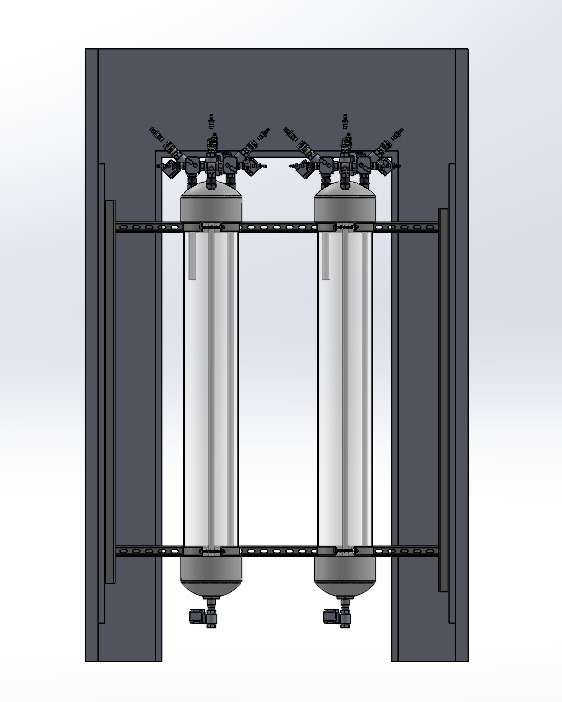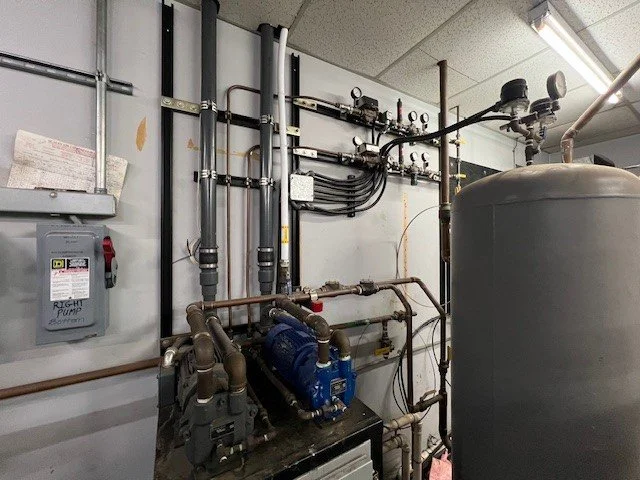Redesign of local collection system Vessels
Improved design of the local collection vessels is desired to accomplish several laboratory workflow goals.
Increased flexibility of Lab layout and better workflow of cleaning. The figure shows redesigned Tissue culture hood carriage with floor lock casters for mobility and a local vessel that is attached with the hood carriage so that location in the lab of the hood and collection system is autonomous with the hood as a complete system.
The siting of the vessel under the hood impacts the vessel volume therefore a greater diameter vessel was proposed, noting that diameters must match available schedule 80 plumbing fittings to reduce design and fabrication cost. To accommodate the increased diameter the implosion shield was removed from the original design. Calculations showed that implosion risk under the conditions had a sufficient safety factor for safe system operation under all conditions.
A new restraint system was designed to reduce cost and increase flexibility for the restrain attachment of the vessel to the Tissue Culture hood carriage. These components are off the shelf and do not require fabrication welding and additional wall anchors as did the previous design.
Specification of angled plumbing connectors to provide clearance and ease of maintenance wrt disconnection of the waste and vacuum tunes, quick disconnection fittings as shown were recommended. Waste carrying pipes were recommended to terminate in disconnect “lock-off” quick disconnects so that contaminated waste material will not spill during removal of the connection.
.
Design and CAD
Design for ease of fabrication included the specification of schedule 80 NPT pipe thread to slip fittings widely available. These fitting specified have stainless collars to prevent thread collar splitting when threaded tightly (too tightly) with NPT connectors that have tapered treads.
The recommended method of fabrication is to drill the Schedule 80 vessel cap to closely accommodate the external diameter of the slip end of the connectors and to glue with Code approved methods using PVC thinner and PVC cement. Fittings shown at right and head design with clearance for valve motors shown at left.
Redesign of Central Collection and Treatment Vessels systems
Improved design of the Central collection vessels is desired to accomplish several goals. A reduction in the number of penetrations into the vessel is achieved by the design where mutually exclusive operation is possible. shown on the left figure. Clearance for larger electrically activated diameter valve bodies required a careful redesign of cap penetration placement and fitting choices. Fabrication costs were kept low by the recommendations for fabrication methods described above for local collection vessels.
A new restraint system was designed to reduce cost and increase flexibility for the restrain attachment of the vessel to the laboratory walls. These components like the under carriage vessel restraints are off the shelf and do not require custom fabrication, welding and fewer wall anchors compared to the previous design.
Specification of angled plumbing connectors to provide clearance and ease of maintenance wrt disconnection of the waste and vacuum tunes, quick disconnection fittings as shown were recommended. Waste carrying pipes were recommended to terminate in disconnect “lock-off” quick disconnects so that contaminated waste material will not spill during removal of the connection.
.
Restraint of the central collection vessels was simplified and custom welded restraints were eliminated. The vessels are designed to be installed in a wall alcove adjacent to a plumbing chase in the laboratory.
Significantly this waste system design increased the number of vessels that could be used in tandem in the treatment of waste so that waste treatment sterilant contact time cycling did not interrupt lab operations.
The new operation procedure uses a fallow vessel that is switched into operation as the full vessel is switched out of operation for treatment. This allows continuous uninterrupted collection of waste without interruption in Vacuum pressure for all waste generating processes and automated instruments in the laboratory.
The recommendation to supply a refillable concentrated “Simple Green” sterilant vessel decreases the production of Chloramines generated by bleach treatment and provides OSHA approved and environmentally more sustainable sterilization procedures. Shown in the Right image.
Finally this new design recommends that both Local and Central treatment vessels be sparged with distilled water during the draining process thus cleaning the walls of the vessel for appearance and maintenance ( for safety these vessels are not designed to be opened).
The heart of the liquid collection and treatment disposal system is the Central Waste Disposal Vessels, however the organs of this system are the Local Collection Vessels. To mitigate the failures of the existing (version 1) system a redesign and replacement of multiple elements of the system system is required.
Plumbing recomendations, that are outside of the scope of the vessel replacement and redesign project, are also to be completed in parallel.
The salient features of the pluming reconfiguration are:
increased diameter of in-ceiling waste receiving transit pipes. 1-1 1/2 inches recommended.
all inlets of the transit pipes are to enter from above so that liquid cannot backflow to local reservoirs.
sewer pitch on the transit pipes for passive flow.
eliminate low spots in the pipes by changing the material to copper from existing spiral reinforced PVC pipe.
increased chemical resistance for PVC solvents such as dimethysulfoxide containg waste. (copper)
The supplied Vacuum pump is a water seal pump and is sensitive to backflow of material through the vacuum lines, particularly if particulate material is aspirated. To mitigate this vulnerability additional pump in tandem configuration is recommended as a failover backup.









